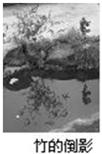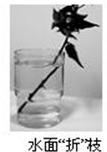(二) 阅读下面短文,回答下 * * 道题。
尘埃无处不有,虽然它们的个体很小,但汇聚起来威力却不小。据记载,北美大陆在20世纪30年代发生的一次尘暴中,狂风将美国平原的泥土大量向东吹去,有难以估计的牲畜被尘埃窒息而死。尽管如此,尘埃的积极作用却是不可低估的。悬浮在大气中的尘埃粒子,能够将太阳光中的较短光柱拦截,使其进行有规则的发散,这样,才会使天空呈现蔚蓝,在太阳升起和降落时,由于阳光穿过较低层的空间,空气中的尘埃密度大,并伴有水汽,可以吸收和反射阳光中的黄色和红色部分,因此,这时看到的太阳呈现橙色、红色和黄色。气象学家指出,在降雨时,每一个雨滴都必须有一颗尘埃参与,以它作为核心,水汽在其周围凝结,形成云、雾,再由云层形成雨点。若是纯净的空气中没有尘埃的存在,水分子无所依附,就不能形成雨滴降落。此外阳光在射向地球的时候,因受到尘埃的吸收和反射,能使地球上的生物得到适量的光照,以满足生长发育所需要。
现代科学发现,有的尘埃在一定的条件下会发生爆炸,这种现象被称作“尘炸”。据解析,能够产生尘炸的物质有粮食粉尘、砂糖、奶粉、咖啡、金属粉末以及其他非金属粉末等。物质发生爆炸,是一种剧烈的化学反应。而化学反应的速度与反应物质的颗粒大小有关。物质分散得越细,颗粒越小,它的表面积就越大。与具有固定面积的物质相比,接触空气吸附氧分子多,氧化和放热的过程都很快,反应性能就更活泼。当其中的某一质点被火点燃,就会发生连锁反应,产生爆炸。此外,易爆尘埃的颗粒越细,浓度越大,它所产生的爆炸力就会越强。当粉尘含量低于大气含氧量一半时,就不会引起爆炸,物质形成“尘炸”,还和诱因、速度等因素有关。产生“尘炸”的诱因很多,其中最主要的是摩擦冲击以及电器设备或静电产生的火花。
随着现代城市的迅速发展,人们发现尘埃已经成为一种危及环境和人类健康的污染物。流行病学家对尘埃进入人体后的机理进行研究后指出,人们在呼吸时,每次大约要吸入50万个浮游微粒;这些微粒进入人的身体后,可以一直进入肺部深处,并作为经常性刺激物留在那里,它会导致发生炎症,产生黏液,使人呼吸困难,甚至导致死亡的发生。除此之外,浮游微粒还可以向肺部传送化学污染物,而且在传送过程中,可以加速一种叫做游离基的有害物质的产生,从而进一步加剧有害物质对人体的危害程度。进入人体内的浮游微粒尘埃,主要来源于工业废弃物、汽车尾气及建筑、装饰材料中的化学成分。资料表明,在我们生活环境内排放的浮游微粒70%来自人为因素。另据调查,哮喘病、肺炎、心脏病等疾病的发病率,都与浮游微粒的增减有关。
(节选自《百科知识》2002年7月份)
下列对“尘炸”现象的表述不正确的一项是( )。
A.砂糖、面粉、铝粉、铁粉、咖啡、干奶粉等都是能产生“尘炸”的物质
B.易爆尘埃分散得越细,颗粒越小,表面积就越大,反应性能就更活泼,产生“尘炸”的可能性就越大
C.“尘炸”的威力与物质分散的颗粒大小有关:颗粒越大,尘埃的浓度也就越大,“尘弹”的威力也越大
D.产生“尘炸”的诱因最主要的是摩擦冲击以及电器设备或静电产生的火花
参考答案:C
解析: 应该是“颗粒越小,尘埃的浓度也就越大,‘尘炸’的威力也越大”。




